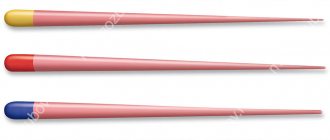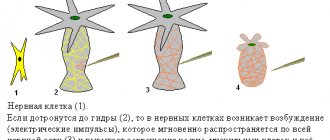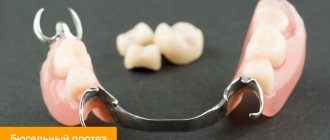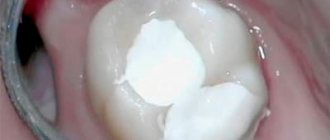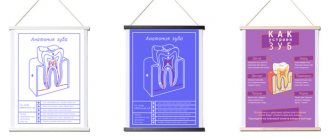The specific structure of the root canal determines the presence of a large number of branches, also known as microchannels. In situations where, as a result of filling, at least one of these cavities remains unclosed, there is a possibility of developing an inflammatory process, which, if prolonged, leads to tooth loss. The Thermafil system, which uses a soft gutta-percha composition, allows you to avoid such situations and achieve high-quality fillings.
General overview
The technology under consideration is one of the new methods of dental treatment, and guarantees the reliability of filling by placing heated gutta-percha in the cavity of the open canal, the basis for which is a plastic obturator. Three-dimensional obturation and complete sealing of the apex eliminate the likelihood of negative side processes that occur during the rehabilitation period. In addition, filling technology reduces the duration of the procedure and is recommended for use even with severe curvature of the canals.
Developed by Professor Johnson, the technology initially involved the use of medical steel rods coated with a layer of plastic material as a carrier. In modern Thermofil models, rigid polymer obturators of various diameters and tapers are used, on which marks are applied to facilitate control of the immersion of the equipment.
Heated gutta-percha has improved adhesive properties, ensuring tight fixation both at the base and in the cavity of the tubules. The presence of a plastic rod prevents shrinkage of the material. The method of using the system includes:
- Treatment of the obturator with a filling mass;
- Gradual introduction of the pin into the canal cavity;
- Natural filling of branches and volume as a result of the created pressure.
The technology of volumetric filling reduces the likelihood of infection of dental tissue, and allows you to reduce the amount of composite materials, which represent a potential source of negative impact on the jaw region. Practice shows that the painful sensations characteristic of the recovery period after medical intervention are expressed to a lesser extent.
It is worth noting that the protocol under consideration is associated with the clinic’s expenses for the purchase of special equipment, including a drill equipped with an endodontic attachment, an oven for softening gutta-percha, as well as sets of disposable instruments. As a result, the cost of treatment with the Thermafil system is higher than with alternative methods.
Filling technique using thermophile
The Thermofil system is a specific set of filling pins, as well as a special device for heating gutta-percha. Sealing obturators (pins) have a cone-shaped appearance, and are made in the form of rods, the outer part of which is covered with a thin layer of molten gutta-percha. The filling method using thermophile consists of several stages, the first of which removes the pulp - a neurovascular bundle located inside the tooth. Next, with the help of special instruments, the root canal is expanded and infected dentin is removed from it.
Next, using a special apex locator, the doctor determines the length of the canal, after which it is given a full and high-quality antiseptic treatment using sodium hypochlorite or chlorhexidine. After this, the canal is dried with paper-type pins, which are inserted into the internal cavity of the tooth. The next stage is direct filling, which is performed using the thermophilic method. Heated paste is applied to the walls, and all microchannels are filled, after which gutta-percha is injected into the main channel to a certain level, after which the obturator is cut off in the area of the mouth. At the end of the operation, an x-ray is necessarily taken, in which you can see the result of the filling.
Stages of filling
The algorithm for restoring the integral structure of the crown includes the following steps:
- Removal of pulp and expansion of the canal opening;
- Formation of a cone-shaped cavity and extraction of infected dentin;
- Determination of the working depth of the channel;
- Antiseptic treatment of all internal areas;
- Rinsing the cavity with a chlorhexidine solution;
- Drying and introducing sealer;
- Installation of a polymer rod and filling the lumen;
- Removing excess material;
- Polymerization of gutta-percha at the mouth of the canal;
- X-ray examination and repeated disinfection.
Implementation of the protocol requires special attention to a number of factors that can affect the quality of filling.
Correct determination of working depth
Because the technique involves filling the canal and all branches, it is important to ensure that the material used is sufficient to reach the bottom of the cavity. Otherwise, there is a high probability of developing complications, including inflammatory processes, pain, cyst formation or periodontitis.
Compliance with channel processing techniques
Mechanical expansion of the hole, elimination of existing defective areas and irregularities - all these are factors affecting the quality of filling the cavity with gutta-percha material. This is especially important when working with narrow and curved canals that require careful processing.
Filling root canals with Thermofil
The expression “nature abhors a vacuum” applies very appropriately to dentistry, namely to root canal treatment. There is probably not a person who is not familiar with such a dental procedure as removing a nerve from a tooth with subsequent filling of root canals. This is otherwise called endodontic treatment. Nerves have to be removed from teeth for many reasons, but most often due to complications of caries - pulpitis and periodontitis. After the nerve is removed from the tooth, an ignorant person may think that the treatment can be completed at this stage. The tooth doesn’t hurt, you can chew – what else do you need? But it's not that simple. An empty root canal, in fact, is an ideal “incubator” for the proliferation of pathogenic microbes. For the same reason, there are often relapses of inflammation in the peri-root tissues of teeth with incompletely or loosely sealed root canals. That is why in dentistry there are strict requirements for the quality of filling (obturation) of the root canals of teeth.
The generally accepted quality standard for root canal filling is dense and complete filling of the root canal. Density is ensured by the physical properties of the filling material, and completeness is ensured by the doctor’s qualifications. The fact is that the root canal must be sealed up to the apical hole, located at the tip of the root. Underfilling threatens with inflammatory complications (formation of cysts, granulomas), and overfilling (filling material extending beyond the root apex) can lead to pain after tooth treatment. The quality of filling the equine canals directly depends on the skill of the doctor.
Fig 1 Fig 2
Fig1. Cyst formation as a result of poor-quality root canal treatment
Figure 2. Fully sealed root canals
The main material for obturation (filling) of root canals is gutta-percha. Gutta-percha is a plant product obtained from the milky sap of tropical plants. In dentistry, specially processed gutta-percha is used, which gives it the required properties (density, radiopacity, flexibility, etc.). At the beginning of the 19th century, gutta-percha was recognized as the best material for filling root canals. From that moment on, scientists began to develop methods for using gutta-percha in dentistry.
Over time, dental materials and technologies have improved, which ultimately led to the emergence of such a root canal filling system as Temafil (Thermafil). Thermophil is a system for filling the root canals of teeth with heated (softened) gutta-percha.
Thermofil system for filling root canals consists of filling pins and a special heating device for softening the gutta-percha of the filling pin.
Fig 3 Fig 4
Fig 3. Thermafil obturators
Fig. 4. Device (oven) for heating obturators
A filling pin (obturator) is a cone-shaped rod (can be plastic or metal) coated with a thin layer of gutta-percha.
The method of filling root canals with the Thermafil system consists of several stages. First, the nerve (pulp – neurovascular bundle) is removed from the root canal using special instruments. The root canal is then widened and given a conical shape. During the expansion process, a layer of infected dentin (the inner tissue of the tooth) is removed from the walls of the root canal. To determine the length of the root canal, a special device is used - an apex locator. It allows you to very accurately determine the working length of the root canal, which is necessary for its full treatment and filling.
Fig 5 Fig 6
Fig 5. Apex locator
Fig 6. Instruments for mechanical treatment of root canals
An indispensable condition for complete root canal treatment is its high-quality antiseptic treatment. To do this, the canal is washed repeatedly during the treatment with a solution of a strong antiseptic (sodium hypochlorite, chlorhexidine).
When the root canal is mechanically and antiseptically treated, it is dried with paper points, which are inserted into the lumen of the canal.
Now you can proceed directly to filling the canal. Filling the root canals completes the treatment of pulpitis and the treatment of periodontitis. A special limiter on the Thermofil pin sets the length to which the obturator must be inserted to completely fill the root canal. Then the obturator is heated with a device to soften the gutta-percha. Before filling, a thin layer of sealant is applied to the walls of the root canal - a special paste that ensures the filling of all micro-branches of the canal. The heated obturator is smoothly inserted into the root canal up to the limiter. After which the obturator is cut to the mouth of the root canal and an X-ray image of the filled tooth is taken. After making sure that the root canal is fully filled, you can begin restoring the tooth, which is done at your next visit to the dentist.
Fig 7 Fig 8
Figure 7. Root canal filling with Thermafil obturator
Fig. 8. The obturator is cut to the level of the entrance to the root canal (canal mouth)
Advantages of the Thermophile method
The root canals of teeth have a complex anatomical structure. In most cases, the main root canal has many side branches - microchannels. As a rule, these branches are present in the apical third of the root canal - the area most critical to the quality of the filling. Unsealed branches of the main canal are potential sources of infection, leading to inflammatory complications and, as a result, tooth loss.
Fig 9 Fig 10
Fig. 9. An extensive network of branches of the root canal
Fig. 10. Complete obturation of the main canal and its branches with Thermafil
Conventional root canal filling methods do not always achieve the desired result, and voids present in the root canal after poor-quality filling often lead to complications.
The technique of filling canals with Thermofil does not have these disadvantages. Softened gutta-percha, introduced under pressure into the canal on a carrier (rod), completely fills the entire volume of the root canal, including its branches. When filling, the doctor clearly controls the depth of insertion of the rod, which allows the canal to be accurately filled to the apical foramen. The plasticity of the carrier (rod) makes it possible to fill even highly curved root canals. If it is necessary to re-treat or prepare the root canal for a pin structure (restoration of a tooth on a pin, restoration with a core inlay), Thermafil can be easily removed from the root canal.
X-ray pictures. Complete filling of root canals with Thermafil
The conducted studies have proven excellent sealing of the root canal after filling with Thermofil. It is 20 times higher than when filling the root canal with a conventional gutta-percha pin and four times higher than the same indicator when filling the root canal by introducing gutta-percha using a syringe.
Advantages and disadvantages
Positive aspects noted when using the Thermophile system include:
- Guaranteed sealing of the canal cavity;
- Minimal risk of inflammation after filling;
- Low level of toxicity of materials;
- Preservation of an integral apical structure;
- Control over the depth of penetration of the rod;
- Free access for re-treatment;
- No pain during the rehabilitation period.
The only technical drawback characteristic of all composite materials is the likelihood of minimal shrinkage of the formed filling.
GuttaCore™ System: another step in the evolution of endodontics
Andrey Zorian
, Candidate of Medical Sciences, member of the endodontic section of StAR, director of dental education
The system GuttaCore™: another stage of evolution of
Endodontics Andrew Zorian , Candidate of Medical Sciences, Member of the Endodontic Section of Russian Dental Association, Director of Dental Training Center Harmony
Use of obturators on the media – one of the world's most popular tech root canal, which is enjoying a well-deserved recognition of the leading experts in the field of endodontics. However, many dentists are still biased against the use of obturators, giving preference to the lateral or vertical condensation of gutta-percha. The main reason for this is the existence of myths about the common places of gutta-percha on the media, often contradicting each other. Development of obturators GuttaCore™ – a truly revolutionary step in the evolution of endodontics. Use of this system allows you to quickly and easily achieve high-quality threedimensional obturation in situations where the physician may face certain problems.
The use of carrier-based obturators (Thermafil, GT Obturator, ProTaper Obturator) is one of the most popular root canal filling techniques in the world, enjoying well-deserved recognition from leading experts in the field of endodontics.
Gutta-percha on a carrier: for or against?
This simple and effective technique can significantly reduce the doctor’s working time, while ensuring high quality obturation, especially in narrow root canals and canals with complex anatomy [4–6, 9] ( Fig. 1, 2
). However, many dentists remain prejudiced against the use of obturators, preferring lateral or vertical condensation of gutta-percha. The main reason for this is the existence of common myths about gutta-percha on the carrier, which often contradict each other.
| Rice. 1-2 Root canals with pronounced curvature, filled with gutta-percha on a carrier |
Myth 1: The use of obturators causes periodontal burns, as evidenced by postoperative sensitivity.
Consequently, endodontic treatment will certainly fail. In fact, proper use of gutta-percha on a carrier cannot cause burns to periodontal tissues. The post-filling pain that occurs in some cases is due to the fact that the obturator, during its insertion into the root canal, promotes the air contained in it into the peri-root tissue. This sensitivity goes away on its own without the subsequent development of any complications.
Myth 2: When using obturators, there is a high risk of gutta-percha being removed beyond the root apex.
Despite its simplicity, the filling technique using gutta-percha on a carrier is very demanding in terms of compliance with the rules for the formation of root canals. An important step is the calibration of the apical foramen, since the use of an obturator whose size is smaller than the diameter of the apical foramen can actually lead to the removal of gutta-percha into the periapical tissues. With proper root canal treatment and strict adherence to obturation instructions, this possibility is virtually eliminated.
Myth 3: Only the obturator carrier reaches the apex. Gutta-percha and sealer remain in the mouth and middle third of the canal.
This option is possible if the technique of preparation, irrigation and filling of the canal with gutta-percha on a carrier is not followed. There are several key factors to prevent this problem.
- The orifice of the root canal must be sufficiently widened (funnel-shaped) so that the obturator enters freely without losing gutta-percha as it enters the canal.
- The root canal must be fully disinfected. A prerequisite for high-quality irrigation is the use of sodium hypochlorite solution and preparations to remove the smear layer formed during the formation of the canal, such as a 15–17% aqueous solution of EDTA or citric acid. This approach makes it possible to achieve not only high-quality obturation of the main canal, but also filling of its branches (lateral and deltoid canals, anastomoses between canals) with gutta-percha.
- The mouth and middle parts of the canal must be filled with sealer, ensuring smooth sliding of the obturator along its walls. In this case, the root sealant should not have a too dense consistency. The ideal option is sealers based on epoxy resin: AH Plus (Dentsply), Adseal (Meta Biomed), etc.
- The obturator must be inserted into the root canal slowly and smoothly. Thermafil obturators with a 4% taper are inserted over 3–4 s. Higher taper obturators (GT, ProTaper and WaveOne) – 6–8 sec.
The use of gutta-percha on a carrier allows one to achieve predictable successful results in root canal obturation, which is confirmed by numerous studies [1, 2, 7, 8, 11–17, 19, 20].
Myth 4: Obturators are difficult to remove from the canal during repeated endodontic treatment.
Many clinicians encounter certain problems when it is necessary to unfill a canal filled with gutta-percha on a carrier. This is most often due to the doctor’s lack of appropriate tools. Literature data indicate that this manipulation requires even less time than re-treatment of a canal filled with gutta-percha [10, 18]. The optimal solution is to use machine-made nickel-titanium tools (ProFile, GT, etc.). In my practice, I use ProTaper Retreatment D series files ( Fig. 3
). They allow you to literally remove the plastic carrier of the obturator within a minute, after which removing gutta-percha residues from the canal walls becomes a fairly simple task.
Myth 5: The plastic carrier of the obturator prevents the full preparation of the canal when placing pin structures.
When preparing a canal for a pin structure, before using reamers of the appropriate size, it is necessary to remove the obturator carrier to the required depth. For this purpose, diamond burs are often used (which is quite unsafe), ultrasonic tips and electric heating pluggers (System B, Calamus Dual, BeeFill, etc.). However, in my opinion, the most predictable option is the use of special burs for the turbine handpiece Post Space bur (Dentsply Maillefer, Fig. 4
). They are used without water cooling and allow one movement to remove the plastic carrier from the root canal to the length of the pin structure.
GuttaCore™ system: characteristics and application methods
Thus, the main complaint of doctors about obturators is the presence of a plastic carrier in them.
In the near future, a product will be presented on the Russian market that demonstrates a fundamentally new concept of using gutta-percha on a carrier - GuttaCore™ obturators ( Fig. 5
), the carriers of which are made not of plastic, but of gutta-percha elastomer with cross-linked intermolecular bonds (cross-linked gutta-percha).
Thus, the obturator consists entirely of gutta-percha in different forms ( Fig. 6
). This ensures not only fast and high-quality three-dimensional obturation of root canals, but also ease of preparation of the canal for placing a pin and removing the root filling, if repeated endodontic treatment is necessary. The carrier is removed from the root canals as easily as gutta-percha, since it is gutta-percha. Therefore, for these purposes we can use the same instruments as in canals filled using the lateral or vertical gutta-percha condensation technique.
Working with the GuttaCore™ system is very simple, but there are a number of key points to avoid mistakes when using it.
| Rice. 5 GuttaCoreTM obturators | Rice. 6 Structure of the GuttaCoreTM obturator | Rice. 7 GuttaCoreTM blister | Rice. 8 Channel size verifier |
Step-by-step sequence of application of GuttaCore™ obturators
The root canal must be properly formed and disinfected. The GuttaCore™ system is universal, i.e. can be used regardless of what instruments the canal was processed with. However, according to research, after preparation, root canals should have either a taper of at least 6% (.06) or a large apical foramen diameter. This is necessary to ensure their high-quality irrigation and three-dimensional obturation [3]. When using the GuttaCore™ system, the root canal must be expanded to a minimum size of 20.06 or 25.04.- The appropriate GuttaCore™ obturator size should be selected. If instruments with a taper of .06 or greater were used for root canal preparation, an obturator that is the same size as the finishing nickel-titanium file is selected. If tools with a taper of .04 were used, then one size smaller (table). Under no circumstances should gutta-percha be cut from the tip of the obturator, as this may damage the wearer.
- An important step to ensure predictable and high-quality three-dimensional obturation is root canal calibration. For this purpose, in addition to five obturators, each GuttaCore™ blister contains a verifier of the appropriate size and taper ( Fig. 7, 8
). This is a hand-held instrument that is passively inserted into the working length of the root canal. If the verifier is not passively fitted to its full length, it can be used as a finishing file to further widen the apical portion of the canal. - When using GuttaCore™ obturators, the sealer is applied in a thin layer only to the mouth or, in the case of long root canals, to the mouth and middle part of the canal. To apply the sealer, you can use a paper pin, a sharp probe, or, when using AH Plus Jet sealer, a special mixing nozzle ( Fig. 9
). During insertion, the heated obturator will evenly distribute the root sealant along the walls of the root canal. If there is an excessive amount of sealer or if it is applied to the full working length, there is a high risk of extrusion into the periapical tissue. - The working length is set on the obturator, after which it is placed in the holder of one of the heating elements of the Thermaprep 2 oven (rice. 10
). The distinctive characteristics of the furnace are the rapid three-dimensional heating of the obturators while maintaining the properties of the gutta-percha carrier, as well as the possibility of simultaneous operation of both heating elements. In the GuttaCore™ system, unlike obturators with a plastic carrier, the minimum heating level is set on the working panel of the furnace, regardless of the size of the obturator - 20–25 (
rice. eleven
). By gently pressing the holder, the obturator is placed into the Thermaprep 2 heating element (
rice. 12
). At the same time, the oven’s operating cycle automatically starts and the indicator light lights up. The possibility of simultaneous operation of both heating elements allows, if necessary, to heat two obturators at once. When heating is complete, the oven will beep and the indicator light will start flashing. By gently pressing, lift the holder, remove the obturator and slowly, without rotating, insert it into the root canal to the working length. In case of difficult access to root canals, especially in the lateral teeth when opening the mouth is difficult, the GuttaCore™ obturator carrier can be fixed using tweezers (
rice. 13
), remove the handle by shaking it from side to side, and, holding the obturator with tweezers, insert it into the canal (
rice. 14
). - After inserting the obturator into the root canal, the plasticized gutta-percha can be condensed at the orifice using a plugger. This creates additional hydrodynamic pressure, allowing gutta-percha to even better fill the branches of the main canal, such as the lateral and deltoid canals, anastomoses between canals, etc. During the condensation process, it is necessary to firmly hold the obturator by the handle to prevent it from moving.
- The final stage of obturation is the removal of the handle and carrier above the level of the orifice. When using the GuttaCore™ system, there is no need to use special Thermacut burs for this purpose. You can either cut the carrier off at the mouth level using a regular ball bur or a sharp excavator, or simply break it off with light lateral movements. To clean the tooth cavity from residues of gutta-percha and sealer, use a cotton ball soaked in chloroform or ethyl alcohol.
Conclusion
The evolution of endodontics is moving along the path of simplifying the technical part of the procedures and reducing the doctor’s working time. New instruments, materials, equipment and accessories are being developed to reduce the number of working steps and make endodontic treatment less labor-intensive. At the same time, of course, great attention is paid to simultaneously increasing the predictability of results and the success of treatment in general.
The development of GuttaCore™ obturators is truly a revolutionary step in the development of endodontics. The use of this system allows you to quickly and effortlessly achieve high-quality three-dimensional obturation in situations where the doctor may encounter certain problems when performing other root canal filling techniques ( Fig. 15–17
).
